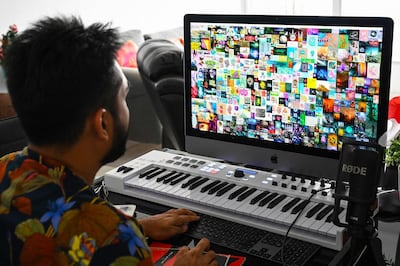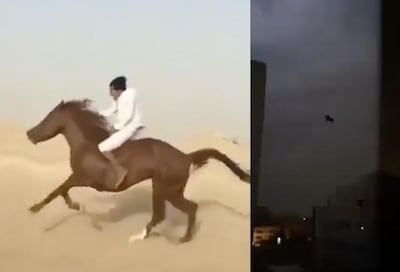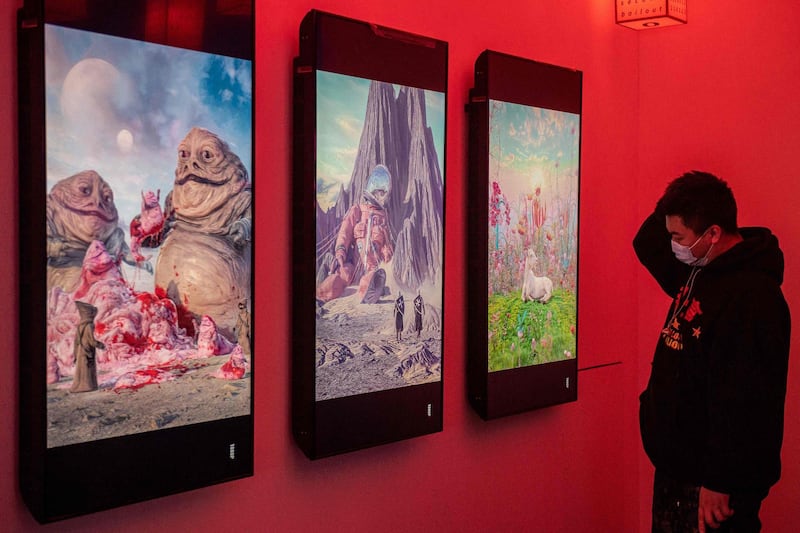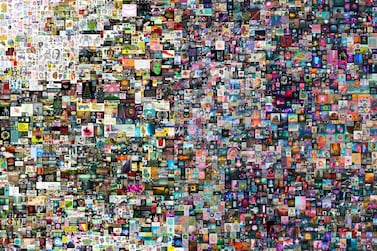Non-fungible tokens caught the world's attention after the $69 million sale of a digital artwork by Beeple at a Christie's auction last month. Many artists and musicians have been dropping NFTs on online platforms recently and more are lining up to enter this seemingly lucrative market.
Artists, including a number from the Middle East, have been drawn to NFTs, because the technology allows their digital artworks to be certified and collected, something that was previously difficult, if impossible, to do. But how does it all work and what are the consequences of "minting" them?
Here, The National explains how they are made and why they are shaking up the art world.
What is an NFT?
An NFT is a type of digital asset that is part of a blockchain and acts as a certificate of ownership for specific items. These items can be images, videoes, music, gifs, even tweets and articles.

Unlike cryptocurrencies, which are interchangeable or fungible, and can be broken into smaller parts, NFTs are non-fungible and cannot be replaced with something else. Each NFT is unique.
When it comes to NFT art, the token is not the work itself. Rather, it is the digital certificate that represents ownership of the work. Cryptoart is another term for NFT art (though not all NFTs are artworks).
How do I buy an NFT?
The process differs according to the platform from which you buy.
Interested buyers will need to have a digital wallet into which they can add money or store cryptocurrency to purchase NFTs online.
They can be bought on marketplaces such as OpenSea, Nifty Gateway, Rarible, SuperRare and more. Some of the marketplaces are more selective about the work they approve and display than others.
How do I make an NFT?
Artists and creators can “mint” – upload and certify – digital media such as videos, animations, music and images on a blockchain, with the Ethereum blockchain being the most popular.
To do this, they need to have a digital wallet and mint their works on the online marketplaces mentioned above.
Once it exists on the blockchain, the NFT theoretically remains there permanently (as long as the chain exists, too).
What has been the impact of NFTs on the art world?
NFTs present an opportunity for digital artists to sell works that previously did not have a big market. The technology allows these digital works, which can be easily downloaded and duplicated, to have a certified “original” and a way to claim ownership.
Artists will still need to register copyrights for their work to protect themselves against counterfeiters, but NFTs allow collectors to buy and resell works like they would paintings, sculptures and other physical items.

Another advantage with NFTs – and possibly the biggest game-changer for artists – is that creators can continue to earn a percentage of the resale of their works. This differs from the traditional art market, where artworks are sold through auction houses and galleries to collectors, who can then resell them for much higher prices without having to give artists any royalties.
NFTs allow artists to keep earning from their work in perpetuity.
What are the environmental concerns with NFTs?
There are several, including the environmental costs around cryptocurrency and blockchain. It is not the NFTs themselves that are producing carbon emissions, but the underlying blockchain technology that has been criticised for fuelling greenhouse gas emissions.
When artists mint an NFT or upload their work, the process of adding that asset to the blockchain requires a lot of computing energy. This is even truer for heavier artwork files.
Computational artist Memo Akten has calculated that the carbon footprint of an average NFT is the same as a month's worth of electricity for a person living in the EU. Akten arrived at this figure after analysing 18,000 NFTs.
While talks of powering mining operations with clean sources are under way, the ecological costs of blockchain technology remain high. There is also a movement towards “Clean NFTs” online, which involves taking small steps to help alleviate the carbon footprint of each work, such as minting an NFT only when the artwork is ready to be purchased and using more energy-efficient blockchains rather than Ethereum.







